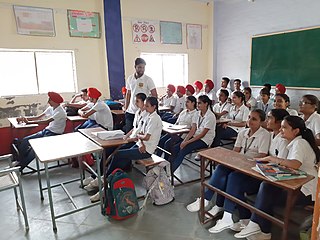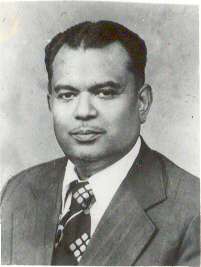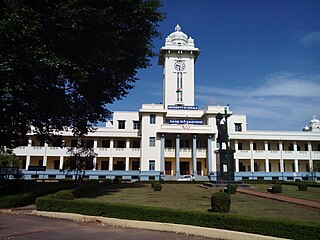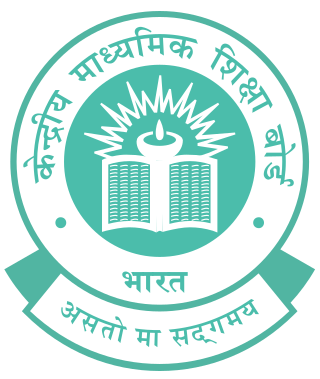
Education in India is primarily managed by the state-run public education system, which falls under the command of the government at three levels: central, state and local. Under various articles of the Indian Constitution and the Right of Children to Free and Compulsory Education Act, 2009, free and compulsory education is provided as a fundamental right to children aged 6 to 14. The approximate ratio of the total number of public schools to private schools in India is 10:3.
Secondary School Certificate (SSC), Secondary School Leaving Certificate (SSLC) or Matriculation examination, is a public examination in Bangladesh, India, Pakistan and Maldives conducted by educational boards for the successful completion of the secondary education exam in these countries. Students of 10th grade/class ten can appear in these. It is equivalent to the year 10 of the GCSE in England or the first two years of high schools in United States.

The Directorate of Government Examinations was formed as a separate directorate in India in February 1975. Prior to the formation of Directorate Of Government Examinations, the then DPI/DSE was the ex-officio commissioner for Government exams and the department was having its office at Madras only. The first secondary school leaving certificate exam was conducted in the year 1911. This directorate started conducting the following major exams from the year noted against each of them in addition to the various examination.
In India, board examinations refer to the public examinations that are conducted at the completion of secondary and senior secondary education.
Kerala Board of Public Examination is the state level education board of Kerala. It is administered by the Government of Kerala. The board is responsible for conducting various examinations on the basis of a unified law. Its headquarters are located at Pareeksha Bhavan, Poojapura, Thiruvananthapuram.

Christ Nagar Higher Secondary school started in 1976 as a private English Medium School in Trivandrum, India, recognised by the state government of Kerala as a minority educational institution. In 2002, Christ Nagar High School was upgraded to higher secondary level. In 2023, due to financial issues the school decided to close its higher secondary education.
In the Indian education system of some Indian states, the pre-university course (PUC) or pre-degree course (PDC) is referred to as intermediate or +2 course, which is a two-year senior secondary education course that succeeds the tenth grade and precedes to the completion of an Senior Secondary Course. The First Year of the PUC is commonly referred to as 1st PUC or Class 11th,, and the Second Year of the PUC as 2nd PUC or Class 12th. A college which offers the PUC is simply known as a 'PU college' or 'Intermediate College' which is also referred to as junior college.

The state of Karnataka in India has well known institutions like the Indian Institute of Science (IISc), Indian Institute of Technology, Dharwad (IIT,DWD) Indian Institute of Management (IIM), the National Institute of Technology Karnataka (NITK), Indian Institute of Information Technology, Dharwad (IIIT), International Institute of Information Technology, Bangalore, Visvesvaraya Technological University (VTU) and the National Law School of India University. In addition, a Visvesvaraya Institute of Advanced Technology (VIAT) is being constructed in Muddenahalli.
Higher Secondary Certificate (HSC), Higher Secondary School Certificate (HSSC) or Higher Secondary Education Certificate (HSEC) is a secondary education qualification in Bangladesh, India and Pakistan. It is equivalent to the final year of high school in the United States and GCSE and/or A level in the United Kingdom.

Harris Sam Sahayam Lawrence was an Indian educationalist born in Nagercoil, Tamil Nadu.

The importance and antiquity of education in Kerala are underscored by the state's ranking as among the most literate in the country. The educational transformation of Kerala was triggered by the efforts of the Church Mission Society missionaries, who were the pioneers that promoted mass education in Kerala, in the early decades of the 19th century. The local dynastic precursors of modern-day Kerala—primarily the Travancore Royal Family, the Nair Service Society, Sree Narayana Dharma Paripalana Yogam and Muslim Educational Society (MES)—also made significant contribution to the progress on education in Kerala. Local schools were known by the general word kalaris, some of which taught martial arts, but other village schools run by Ezhuthachans were for imparting general education. Christian missionaries and British rule brought the modern school education system to Kerala. Ezhuthu palli was the name used in earlier times. The word was derived from the schools run by the Buddhist monasteries. For centuries villages used to set up an ezhuthupally or ashan pallikoodam with one or two teachers. Students used to go this school from nearby areas and learn languages, literature, mathematics, grammar etc. After completing this students may continue study about specific subjects such as ayurveda, astrology, accounting etc. Censuses during 1800 shows that Travancore, Cochin, Kannur areas have many such schools. Even name list of ashans were used to be published along with the census.

The Central Board of Secondary Education (CBSE) is a national level board of education in India for public and private schools, controlled and managed by the Government of India. Established in 1929 by a resolution of the government, the Board was an experiment towards inter-state integration and cooperation in the sphere of secondary education. There are more than 27,000 schools in India and 240 schools in 28 foreign countries affiliated to the CBSE. All schools affiliated to CBSE follow the NCERT curriculum especially from class 9 to 12. The current Chairperson of CBSE is Rahul Singh, IAS.
All India Secondary School Examination ( Secondary School Examination)commonly known as Class 10th board exams, is a centralized public examination that students in schools affiliated with the Central Board of Secondary Education, primarily in India but also in other Indian-patterned schools affiliated to the CBSE across the world. taken at the end of class 10. The board conducts the examination during the period of February- March earlier it was taken in March to April every year. In this exam, Mathematics, Science (Physics, Chemistry, Biology) and Social Science (History, Geography, Political Science, Economics) are compulsory with any two languages (official language of medium and foreign/schedule languages). Students can also opt skill subject such as information technology, painting, yoga, music or artificial intelligence. Successful candidates are awarded the Secondary School Completion Certificate, a Statement of Marks, and a Migration Certificate stating that the candidate has completed Secondary Schooling and can pursue higher education. For the academic year 2016–17, the Central Board of Secondary Education has revived the old system of syllabus and marking scheme (complete syllabus for All India Secondary School Examination and marks out of 500 (in COVID time out of 200) India has state exams and central exams.From 2017 to 2018 And later Academic year use old format

Madhya Pradesh Board of Secondary Education is a board of school education in Madhya Pradesh State of India.

Tamil Nadu is one of the most literate states in India. The state's literacy rate is 80.33% in 2011, which is above the national average. A survey conducted by the Industry body Assocham ranks Tamil Nadu top among Indian states with about 100% Gross Enrollment Ratio (GER) in primary and upper primary education.
Sacred Heart Matriculation Higher Secondary School (SHMHSS) is a matriculation institution in the town of Kayyunni, Gudalur, Nilgiris - Tamil Nadu. The school is a christian missionary educational institution ran by Fathima Matha Trust along with Nilgiri Educational Trust.
Chhattisgarh Board of Secondary Education is a board of education in the state of Chhattisgarh, India. CGBSE is a state agency of the Government of Chhattisgarh, it is responsible for promotion and development of secondary education in Chhattisgarh. The Board has conducted its exams independently from the year 2002, and conducts High School, Higher Secondary and Diploma Courses.
The National Institute of Open Schooling (NIOS), formerly National Open School is a national level board of education in India, controlled and managed by the Government of India. It was established by the Ministry of Education of the Government of India in 1989.

The Department of School Education is one of the departments of Government of Tamil Nadu.








